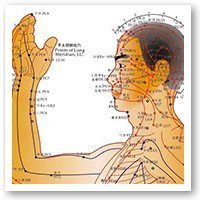Posts
How does Acupuncture work?
/in Acupuncture /by Andrew It might seem bizarre that inserting needles into various points on the body can influence the way our cells work. But a lot of research shows this is the case.
It might seem bizarre that inserting needles into various points on the body can influence the way our cells work. But a lot of research shows this is the case.
One of the areas most studied is the pain-killing effect of acupuncture. We have known for some time now that acupuncture affects nerve conduction within the spinal cord. The basis of the theory is that acupuncture stimulation ‘closes a gate’ within the spinal cord, preventing pain signals from travelling up the spinal cord and getting to the brain.
Beyond this, we also know that acupuncture has hormonal effects. Researchers initially noted that when people addicted to narcotic drugs (like heroin or morphine) had surgery using acupuncture as anaesthesia, they did not experience the withdrawal syndrome that you’d usually expect when the narcotics were stopped. This is because endorphins, the chemicals released by the brain when you exercise that are responsible for the “feel-good” phenomenon, are also released during acupuncture. This effect can be blocked with an endorphin-blocking drug.
We also know that acupuncture increases blood flow at the site needled, probably through local release of biochemically active substances.
Do meridians really exist?
According to Traditional Chinese Medicine, energy (Qi) flows through the body along pathways or meridians, and acupuncture influences this flow. These meridian lines are depicted in texts that are at least 2000 years old.
Scientists have found that electrical resistance of the skin is much lower at acupuncture points (which are mainly situated along the meridians) than other points. This supports the idea of a flow of electrical energy through the body along meridians, which can be accessed via the skin at the acupuncture points.
 But has science found any other evidence that meridians exist?
But has science found any other evidence that meridians exist?
One study injected radioactive tracer molecules into acupuncture points (on meridians) and random points not on meridians. At the acupuncture points, the tracer travelled in a line consistent with the traditional description of the meridian, whereas it just diffused outwards at the non-meridian point.
When we look down a conventional microscope, meridians have been elusive. But some studies using electron microscopy (giving a much more magnified view in which individual cells can be seen) have shown thread-like structures within lymphatics, within blood vessels, on the surface of organs, and elsewhere. These structures appeared to contain fluid and may be the meridians described in ancient texts.
Although further research into this is required, the preliminary findings are fascinating. Clearly we are only just beginning to understand the science behind what the ancient texts described thousands of years ago.
The Musculoskeletal System and its Importance to our Health
/in Chiropractic /by Andrew The Musculoskeletal System consists of bones, muscles, joints and ligaments and tendons that make up the body and allow it to be upright and to have movement. The skeleton is the framework of the body. Of this, the spine is made of 24 movable bones, 23 discs and has attachments for 12 sets of ribs and hundreds of ligaments and muscles. It supports and protects the spinal cord, and allows 31 pairs of nerves to pass from the spinal cord through small openings to muscles, organs, bones and skin.
The Musculoskeletal System consists of bones, muscles, joints and ligaments and tendons that make up the body and allow it to be upright and to have movement. The skeleton is the framework of the body. Of this, the spine is made of 24 movable bones, 23 discs and has attachments for 12 sets of ribs and hundreds of ligaments and muscles. It supports and protects the spinal cord, and allows 31 pairs of nerves to pass from the spinal cord through small openings to muscles, organs, bones and skin.
 But has science found any other evidence that meridians exist?
But has science found any other evidence that meridians exist?